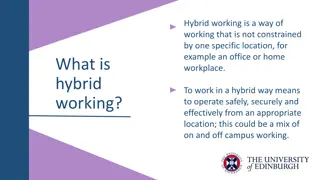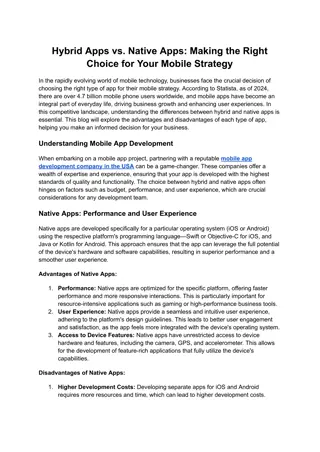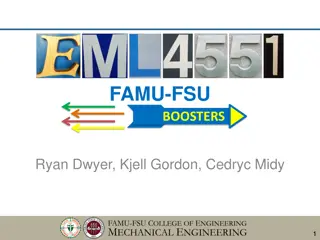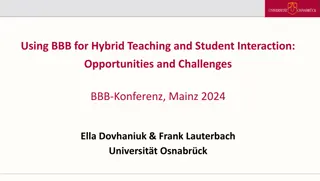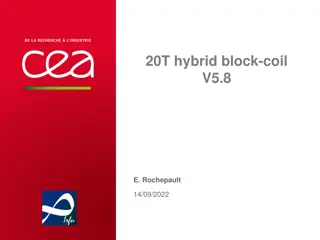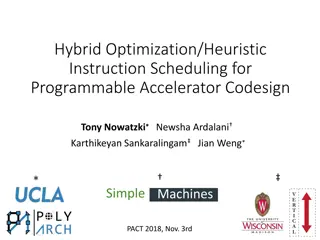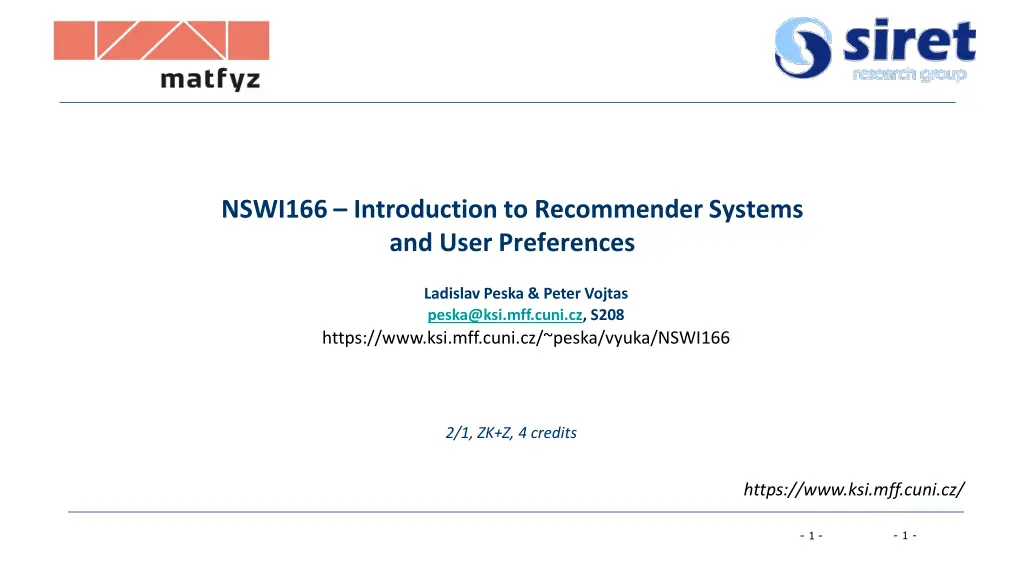
Introduction to Hybrid Recommender Systems and Design Strategies
Learn about hybrid recommender systems and the various design strategies to combine different recommendation techniques, addressing shortcomings and enhancing user experience. Explore parallelized, monolithic, and pipelined hybridization designs in this insightful guide.
Download Presentation

Please find below an Image/Link to download the presentation.
The content on the website is provided AS IS for your information and personal use only. It may not be sold, licensed, or shared on other websites without obtaining consent from the author. If you encounter any issues during the download, it is possible that the publisher has removed the file from their server.
You are allowed to download the files provided on this website for personal or commercial use, subject to the condition that they are used lawfully. All files are the property of their respective owners.
The content on the website is provided AS IS for your information and personal use only. It may not be sold, licensed, or shared on other websites without obtaining consent from the author.
E N D
Presentation Transcript
NSWI166 Introduction to Recommender Systems and User Preferences Ladislav Peska & Peter Vojtas peska@ksi.mff.cuni.cz, S208 https://www.ksi.mff.cuni.cz/~peska/vyuka/NSWI166 2/1, ZK+Z, 4 credits https://www.ksi.mff.cuni.cz/ - 1 - - 1 -
Hybrid recommender systems Hybrid: combinations of various inputs and/or composition of different mechanism Collaborative: "Tell me what's popular among my peers" Content-based: "Show me more of the same what I've liked" Knowledge-based: "Tell me what fits based on my needs" - 3 -
Hybrid recommender systems All three base techniques are naturally incorporated by a good sales assistant (at different stages of the sales act) but have their shortcomings For instance, cold start problems Idea of crossing two (or more) species/implementations hybrida [lat.]: denotes an object made by combining two different elements Avoid some of the shortcomings Reach desirable properties not (or only inconsistently) present in parent individuals Different hybridization designs Parallel use of several systems Monolithic exploiting different features Pipelined invocation of different systems - 4 -
Monolithic hybridization design Only a single recommendation component Hybridization is "virtual" in the sense that Features/knowledge sources of different paradigms are combined - 5 -
Parallelized hybridization design Output of several existing implementations combined Least invasive design Simple combination using e.g., weighted average Some weighting or voting scheme Weights can be learned dynamically Extreme case of dynamic weighting is switching Also suitable for Multiarmed bandits or proportionality preservation algorithms - 6 -
Pipelined hybridization designs One recommender system pre-processes some input for the subsequent one Cascade Meta-level Refinement of recommendation lists (cascade) Learning of model (e.g. collaborative knowledge-based meta-level) Most common case in industry - 7 -
Monolithic hybridization designs: Feature augmentation Hybrid RS, monolithic example #1: Content-boosted collaborative filtering [Prem Melville et al. 2002] Based on content features additional ratings are created E.g. Alice likes Items 1 and 3 (unary ratings) Item7 is similar to 1 and 3 by a degree of 0.75 Thus Alice likes Item7 by 0.75 Item matrices become less sparse Significance weighting and adjustment factors Peers with more co-rated items are more important Higher confidence in content-based prediction, if higher number of own ratings Several more examples on separate slides (Spreading Activation, Hybrid BPR, Visual BPR) - 9 -
Monolithic hybridization designs Hybrid RS, monolithic example #2: Visual BPR Latent factor based approach (similar to matrix factorization) Portion of the item embedding is static Based on a pre-trained visual feature extractor Dimensionality reduction to maintain Collaborative vs. Content-based tradeoff Trained using BPR loss - 10 - https://arxiv.org/abs/1510.01784
Parallelized hybridization design: Weighted n ( ) ( ) i , = rec , u i rec u Compute weighted sum: k k weighted = 1 k Recommender 1 Item1 Item2 Item3 Item4 Item5 Recommender 2 Item1 Item2 Item3 Item4 Item5 0.5 0 0.3 0.1 0 1 0.8 0.9 0.4 0 0 2 1 3 2 3 Recommender weighted(0.5:0.5) Item1 0.65 Item2 0.45 Item3 0.35 Item4 0.05 Item5 0.00 1 2 3 4 - 12 -
Parallelized hybridization design: Weighted BUT, how to derive weights? Estimate, e.g. by empirical bootstrapping Dynamic adjustment of weights https://en.wikipedia.org/wiki/Multi-armed_bandit How rewarding were individual recommenders? Empirical bootstrapping Historic data is needed Compute different weightings Decide which one does best incremental updates / multiarmed bandits Dynamic adjustment of weights Start with for instance uniform weight distribution For each user adapt weights to minimize error of prediction - 13 -
Parallelized hybridization design: Weighted Let's assume Alice actually bought/clicked on items 1 and 4 Identify weighting that minimizes Mean Absolute Error (MAE) Absolute errors and MAE MAE improves as rec2 is weighted more strongly Beta1 Beta2 rec1 rec2 error MAE 0.1 0.9 Item1 0.5 0.8 0.23 0.61 Item4 0.1 0.0 0.99 = n 1 ( , ) rec u i r 0.3 0.7 Item1 0.5 0.8 0.29 0.63 k k i = r R k MAE i Item4 0.1 0.0 0.97 R 0.5 0.5 Item1 0.5 0.8 0.35 0.65 Item4 0.1 0.0 0.95 0.7 0.3 Item1 0.5 0.8 0.41 0.67 Item4 0.1 0.0 0.93 0.9 0.1 Item1 0.5 0.8 0.47 0.69 Item4 0.1 0.0 0.91 - 14 -
Parallelized hybridization design: Weighted BUT: didn't rec1 actually rank Items 1 and 4 higher? Recommender 1 Item1 Item2 Item3 Item4 Item5 Recommender 2 Item1 Item2 Item3 Item4 Item5 0.5 0 0.3 0.1 0 1 0.8 0.9 0.4 0 0 2 1 3 2 3 Be careful when weighting! Recommenders need to assign comparable scores over all users and items Some score transformation may be necessary Stable weights require several user ratings !! - 15 -
Parallelized hybridization design: Switching Requires an oracle that decides on recommender ( ) i , = 1 : ( , ) k n rec u i rec u 1 switching k Special case of dynamic weights (all except one Beta is 0) Example: Ordering on recommenders and switch based on some quality criteria E.g. if too few ratings in the system use knowledge-based, else collaborative More complex conditions based on contextual parameters, apply classification techniques - 16 -
Parallelized hybridization design: Mixed Combines the results of different recommender systems at the level of user interface Results of different techniques are presented together Recommendation result for user ? and item ? is the set of tuples < ?????,? > for each of its ? constituting recommenders ???? n = k = ( , ), rec rec u i k mixed k 1 - 17 -
Parallelized hybridization design: Mixed Broden et al.: Ensemble Recommendations via Thompson Sampling: an Experimental Study within e-Commerce Pool of several recommenders R1, ,Rk For each position in the list of recommendations, we first select which Recommender is used and then fill in the position Some basic filters such as non-repeating of items The probability to select Recommender corresponds to its performance in the past (how often were their items clicked/purchased/ ) Using multi-armed bandits variant: Thompson Sampling For each Recommender, we collect number of trials and number of successes Use this as parameters to the Beta distribution (https://en.wikipedia.org/wiki/Beta_distribution) Mean value corresponds to the success probablity Distribution is more compact with more trials Sample value from this distribution Use the Recommender with the highest value One more example on separate slides (fuzzy D Hondt) - 18 -
Pipelined hybridization designs: Cascade Successor's recommendations are restricted by predecessor = ( , ) ( , ) rec u i rec u i cascade n Where forall k > 1 ( , ) : ( , ) 0 rec u i rec : u i 1 k k = ( , ) rec u i k 0 otherwise Subsequent recommender may not introduce additional items Typical in large-scale scenarios (use simple models to reduce the set of candidates, then refine its ordering) Thus produces very precise results - 20 -
Pipelined hybridization designs: Cascade Recommendation list is continually reduced Find acceptable product categories, then select items from within them First recommender excludes items Remove absolute no-go items (e.g. knowledge-based) Second recommender assigns score Ordering and refinement (e.g. collaborative) Context-awareness may be reasonable for the first-level recs. - 21 -
Pipelined hybridization designs: Cascade Recommender 1 Item1 Item2 Item3 Item4 Item5 Recommender 2 Item1 Item2 Item3 Item4 Item5 0.5 0 0.3 0.1 0 1 0.8 0.9 0.4 0 0 2 1 3 2 3 Ordering and refinement Removing no-go items Recommender 3 Item1 Item2 Item3 Item4 Item5 0.80 0.00 0.40 0.00 0.00 1 2 - 22 -
Pipelined hybridization designs: Cascade Industry level - 23 -
Pipelined hybridization designs: Meta-level Successor exploits a model delta built by predecessor = ( , ) ( , , i u ) rec u i rec meta level n rec 1 n E.g., fill-in latent factors in matrix factorization with the help of items content similarity Examples: Fab: Online news domain CB recommender builds user models based on weighted term vectors CF identifies similar peers based on these user models but makes recommendations based on ratings Collaborative constraint-based meta-level RS Collaborative filtering learns a constraint base Knowledge-based RS computes recommendations - 24 -
Limitations of hybridization strategies Only few works that compare strategies from the meta-perspective Like for instance, [Robin Burke 2002] Most datasets do not allow to compare different recommendation paradigms i.e. ratings, requirements, item features, domain knowledge, critiques rarely available in a single dataset Thus few conclusions that are supported by empirical findings Monolithic: some preprocessing effort traded-in for more knowledge included Parallel: requires careful matching of scores from different predictors Pipelined: works well for two antithetic approaches Netflix competition "stacking" recommender systems Weighted design based on >100 predictors recommendation functions Adaptive switching of weights based on user model, context and meta-features - 25 -
Literature [Robin Burke 2002] Hybrid recommender systems: Survey and experiments, User Modeling and User-Adapted Interaction 12 (2002), no. 4, 331- 370. [Prem Melville et al. 2002] Content-Boosted Collaborative Filtering for Improved Recommendations, Proceedings of the 18th National Conference on Artificial Intelligence (AAAI) (Edmonton,CAN), American Association for Artificial Intelligence, 2002, pp. 187-192. [Roberto Torres et al. 2004] Enhancing digital libraries with techlens, International Joint Conference on Digital Libraries (JCDL'04) (Tucson, AZ), 2004, pp. 228-236. [Chumki Basuet al. 1998] Recommendation as classification: using social and content-based information in recommendation, In Proceedings of the 15th National Conference on Artificial Intelligence (AAAI'98) (Madison, Wisconsin, USA States), American Association for Artificial Intelligence, 1998, pp. 714-720. - 26 -






